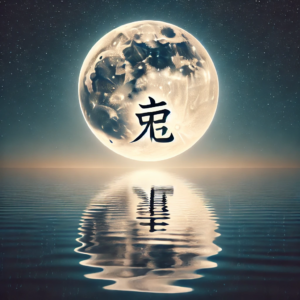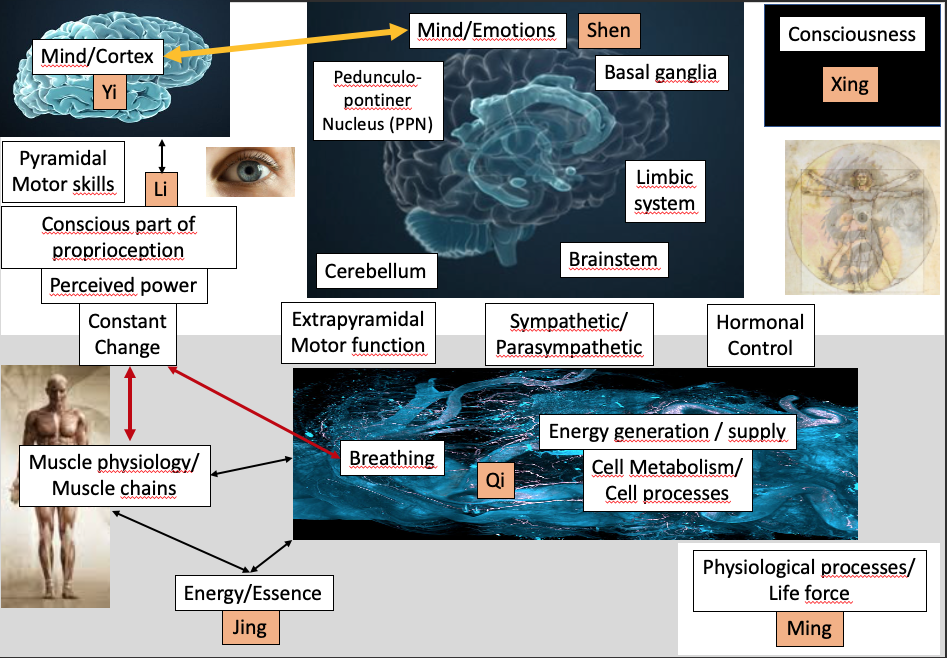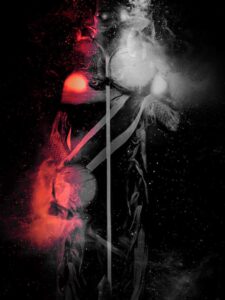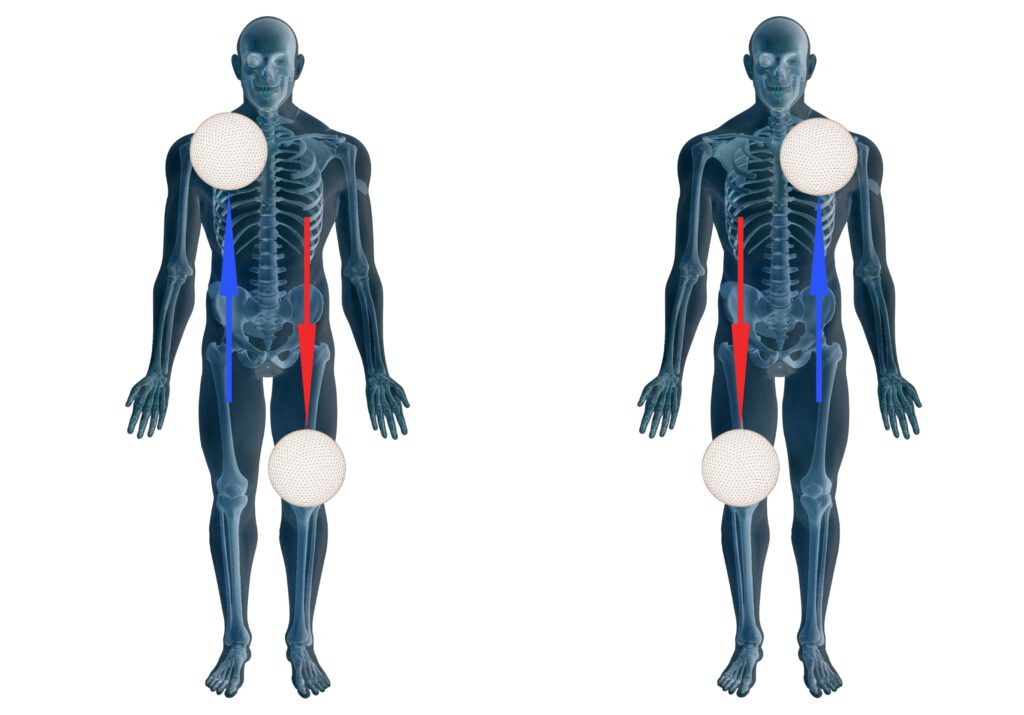At this point we now come to a Chinese concept, or term, which summarizes all the things written on this homepage so far very well:

Yi.
“Yi”, translated into English, means something like ‘mind’.
However, if you look at the Chinese character for “Yi” 意, you can see that it is made up of the character for “voice”, or “sound”, and the character for “heart”.
“Yi” therefore means ‘the voice that comes from the heart’.
To understand why a “voice from the heart” has something to do with our mind, we need to look at the article “What is reality” again. In it, we learned that our mind is always fed with different information: That which our senses transmit directly to the cerebral cortex and that which our emotions communicate to it.
Now let’s take another look at the diagram from the article on “Qi”:

Here we see that our “spirit”, our emotions, is translated as “Shen” in Chinese. In the Chinese view of things, “Shen” has its seat in the heart.
The character for Yi therefore means that our mind “listens” (or should listen) to our feelings, which also corresponds to the Western image of the mind (see “What is reality”). It is the superior authority that controls and evaluates emotions and tries to harmonize them with human action.
In the article on “Roads, networks and movement”, we learned how movement can arise through the use of an idea: My mind chooses an idea, e.g. “The buoyancy of the water moves my army upwards while I am standing on the bottom of the sea”.
This is associated with an emotional experience, as I activate my memories of the feeling of “being under water” and thus visualize the feeling again.
From this feeling, I control my muscles and my arms move upwards “indirectly controlled”.
“Wait a minute!” a lot of people will say, and not without reason. Just because I imagine I’m at the bottom of the sea doesn’t mean my arms will move upwards. That is absolutely correct. The image alone does not move anything in the body.
At this point, I would like to refer you back to the diagram above. We can see how “Yi” uses an image to “communicate” with Shen. The yellow arrow. This triggers the extrapyramidal motor system, which leads to activation of the muscle chains and we perceive the interaction between tension and relaxation as “force”. This perceived force is translated as “Li” in Chinese. Li is therefore the “external”, “obvious”, while “qi” describes the “hidden”, “concealed”. The energy that “drives” movement.
Metabolic processes, neuronal networks etc. were of course unknown to people back then, they described these things with the concept of “qi”, because some form of energy had to exist for muscles to move, breathing to occur, the heart to beat etc.

This brings us to the Chinese saying “Yi commands Qi”.
As in an army, clear instructions are needed for the soldiers so that the formation moves in the right direction and the maneuvers are carried out as the general wishes.
Of course, this is not possible without practice and drill. The commands must be short, clear and easy to implement. Then they have to be practiced again and again and the individual parts of the army have to learn to coordinate themselves.
Let’s come back to the picture “The buoyancy of the water moves my army upwards”. This is the desired movement of the army. However, I have to expand the picture with an idea so that a movement is actually created. This brings us back to the article on the “Didactics of CMA”:
In the article, we wrote about “standing” (Chinese “Zhan Zhuang”, standing like a pillar) and how this teaches you to perceive and control the forces in your own body.

However, these “forces” are nothing mystical, but merely vectors from which movement arises.
So you need an idea in order to develop a FEEL for these forces.
In our specific example with the arms under water, imagine a ball filled with air that you push under the water with your arms. The buoyancy of the ball will passively move your arms upwards.
The energy (physically correct “force”) of the buoyancy could be described as “Qi”, in the West we would say “Archimedes’ principle” (F=p*V*g), whereby the formula would of course not give us a feeling, a ball that we push under water would of course. Here we can perceive the “energy/force” of the buoyancy as a vertical force vector.
Using the idea of the ball that we push under water, we can therefore perceive the vertical force vector and our arms “float” on the ball. We let them rise, carried by the buoyancy.
We now have to repeat the image of standing under water, on the seabed, with the idea of pushing the ball under water again and again in order to form a stable neural network.
However, the movement is not performed on a large scale, but only “thought about” to such an extent that the muscle chains are activated and you can feel the tension. On the outside, you remain motionless while the muscles tense up in accordance with the idea of the force vector. Similar to the movement in the following GIF:

However, to get to a really high number of repetitions, you need to integrate this type of exercise into your daily routine.
There is a very sophisticated system in Chinese martial arts that is designed precisely to train “Yi”. It is about understanding the essence behind the movement (the forces, vectors, planes), for example, and training it through images in such a way that you move as harmoniously and effectively as possible. To do this, you refine your body awareness (via images and ideas) more and more (you “create as many soldiers as possible”) and learn to use them effectively. The images and ideas are part of the training and vary depending on the style and teacher.
To stay with the example of the ball and the water, you would now imagine a ball under each hand for everyday training. One side would push the ball down, while the other side would let the ball rise up. You could then practise this in everyday life, for example, every time you go for a walk (or any kind of walk). This would result in a “clumsy” movement that is somewhat reminiscent of a bear.

Yi, the mind, uses images and ideas to create feelings/emotions that can be used to create movement. Other images and ideas are used, for example, to improve body awareness and control.
In martial arts, there are various external forms that support certain ideas. Some of these forms are movements, some are hand postures, some are static postures.
Once you have learned to feel and generate these “forces” within yourself, you transfer this to your partner. There are also various ideas (planes in space, circles, lines, etc.) and exercises for this.
These ideas can be found in the basic applications of wrestling, sword or spear fighting, more freely in the “pushing hands” where, for example, the vectors and planes (and their applications) can be explored.
To summarize, Yi (our mind) can be trained infinitely. One tries to recognize the essence of things in everyday life (vectors, levels, principles such as change, 5 elements, etc.), to perceive them within oneself and to express them. This is what „Art“ in „martial art“ is all about and what has an impact on your hole life.
